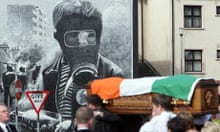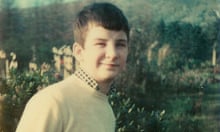Castlereagh interrogation centre in east Belfast, the scene of many of the complaints of police brutality at the heart of current appeals, was a forbidding place with a terrifying reputation.
It was the subject of several Amnesty International complaints, one government commission of inquiry and at least one secret internal police investigation.
For more than 20 years the Royal Ulster Constabulary (RUC) and successive British government ministers maintained that IRA propaganda was largely to blame for its notoriety, and that whatever abuses did occur were the responsibility of a few "rotten apples".
However, a number of former RUC interrogators, men who worked at Castlereagh during the 70s, 80s and 90s, have recently told the Guardian that the beatings, the sleep deprivation and the other tortures were systematic, and were, at times, sanctioned at a very high level within the force.
One told how Detective Chief Superintendent Bill Mooney, the RUC's most senior detective, would fire up his interrogators before they entered the interview rooms, demanding: "What are you, men or mice – get in there!" If they failed to quickly break a suspect, Mooney would ask them: "Have I got to get in there and do it myself?"
At their morning conferences, detectives became reluctant to suggest that a particular suspect "might not be involved" for fear that other interrogators would be assigned to the case and obtain a confession.
While the sources insist that not all suspects were mistreated, both IRA suspects and loyalists were beaten, burned with cigarettes or lighters, forced to assume stressful positions for long periods, stripped and humiliated, and sometimes threatened with murder. Some suffered such severe injuries that they were taken to hospital.
Some two-strong interrogation teams became known for a particular form of abuse, and would be called upon to inflict it on the more recalcitrant suspects.
A handful, for example, specialised in a technique known as "dorsi-flexing" – stretching a suspects' wrists or elbows into painful positions, sometimes for hours at a time. Eventually, one former interrogator recalls, doctors examining suspects after interrogation found that this caused slight swelling. "These men were quietly told: 'Stop it – your system is showing through here'."
Some interrogators simply punched suspects as close to the centre of their stomachs as possible, knowing that soft tissue bruised less when not located near bone.
At other police stations, such as Strand Road in Derry, some suspects were interrogated in bedrooms intended for the accommodation of single officers. "There would be one bathroom for every six or so bedrooms," one source recalls. "The baths would be filled with water and suspects would be forced under."
At Omagh, detectives questioned some suspects inside an enormous disused armoury with heavy steel doors, a place that could unsettle even the interrogators at times.
All the former detectives who spoke to the Guardian said alcohol played a part, with some of the most severe beatings being meted out after interrogators had taken a break, during which they would down a few whiskies or vodkas.
The driving force behind the brutality was a determination to secure more convictions in the judge-only Diplock courts that had been established in 1973 once it became clear that internment without trial was counterproductive.
A couple of dozen young detectives had been formed into specialised interrogation teams in 1975. The following year – which saw the loss of 307 lives, the second-worst annual toll of the Troubles – these teams were expanded. By 1977 they were beginning to see results.
"We were getting headlines every day about the number of people charged, about so-and-so getting 30 years," one former Castlereagh interrogator recalls. "The chief constable was happy, Mooney was happy, the press were happy. Everything was wonderful." Explaining that he thought it "time to set the historical record straight", he added: "There was plenty of slap and tickle. No doubt about it, people were being assaulted."
Another, more bluntly, said he had obtained confessions by employing what he described as "torture, and cruel, inhuman and degrading treatment" – exactly what was prohibited by law.
But in 1977, the former detectives said, they believed genuinely that they were turning the tide, that their strong-arm tactics were starting to win the war against the IRA, and defeat the loyalist gunmen.
Looking back, several former RUC interrogators insist they tried to ensure that suspects confessed only to crimes that their intelligence suggested those individuals had committed. A common refrain was: "We wouldn't have wanted to see men jailed for things they didn't do." Moreover, they maintain that there were probably no more miscarriages of justice in Northern Ireland than in the rest of the UK during that period. "It was a bit rough and ready elsewhere at that time," said one.
Not everybody at Castlereagh was happy during the late 70s, however. Police doctors, on standby to offer suspects an examination before interrogation, and to check them again before they were charged, began to see increasing evidence of mistreatment. Some prisoners required immediate hospital treatment. Some doctors began to complain, both privately and publicly.
Many of the victims would be deeply reluctant to speak out, however, saying they had been warned that worse would follow if they lodged a complaint.
In June 1978, Amnesty published a report calling for a "public and impartial inquiry" into events at Castlereagh. The government appointed Harry Bennett, an English circuit judge, to examine "police procedures and practice" in Northern Ireland. Despite his narrow remit, Bennett came to the unavoidable conclusion that some injuries "were inflicted by someone other than the prisoner himself", and recommended that CCTV be installed in interview rooms so that uniformed RUC officers could watch their plain-clothed counterparts.
Ten months later, when a new chief constable, Jack Hermon, was appointed to lead the RUC, the CCTV cameras had still not been installed. Nevertheless, former interrogators say the frequency of the beatings fell rapidly, almost overnight.
"The new chief constable was completely against any mistreatment of prisoners whatsoever," said one. "We started to detect a change from Bill Mooney straight away. Bill missed the Monday morning conference a couple of times – he was in with Hermon. One day Mooney came out and told us we were not to lay a finger on anybody at Castlereagh."
Hermon, a former head of community relations at the RUC who had a number of close friends among the Catholic clergy, had come to the conclusion that the abuse of prisoners was damaging the reputation of his force to such an extent that it had become counterproductive.
Complaints of severe beatings at Castlereagh did not end completely, however, and a decade later such allegations became common once more.

